Exploring the Royal Tombs of the Nguyen Emperors in Hue - Handspan Travel Indochina
2Hue, one of the most well-known destinations in central Vietnam, appeals to tourists through its historical and cultural values. Besides the Hue Imperial City and sacred temples, the tomb system of the Nguyen Dynasty kings is also attractive. These tombs have sophisticated and artistic architecture, associated with many interesting and meaningful stories. Let’s find out seven royal tombs of the Nguyen Emperors in Hue with Handspan Travel Indochina!
Through this blog post, you will find these pieces of information below.
General information about the royal tombs of the Nguyen Emperors in Hue
The Nguyen Dynasty of Vietnam existed from 1802 to 1945 with 13 kings. However, due to many historical reasons, only 7 royal tombs of the Nguyen Emperors in Hue still exist today. They are Gia Long, Minh Mang, Thieu Tri, Tu Duc, Duc Duc, Dong Khanh and Khai Dinh.
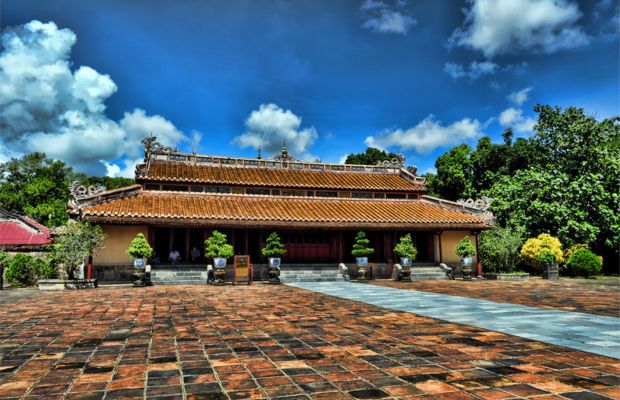
Minh Mang Tomb in Hue
Most of the Hue tombs were built when the king was still on the throne. The artistic and ideological themes were proposed by the king. The architecture was approved by the king and the king himself often supervised the construction. All of the tombs were built and planned based on the Eastern fengshui philosophy. The seven royal tombs of the Nguyen Emperors in Hue are located in a quite separate area in the west of the capital. According to ancient beliefs, when the king died, he and the sun went to the west to rest in peace. This is the reason why the tombs are in the West.
The tomb construction process and construction time are fairly time-consuming, including many steps. They are finding land, drawing a map, determining locations to build structures, preparing materials, labor, transporting materials, starting construction, holding a ceremony to pay homage to the mountain god and earth god, and renovating and restoring. Such a long time is one of the reasons why there are only 7 royal tombs of the Nguyen Emperors while there are 13 kings.
Exploring seven royal tombs of the Nguyen Emperors in Hue
Each of the seven royal tombs of the Nguyen Emperors in Hue has their architectural characteristics and profound philosophies about life. Let’s find detailed information about each of the tombs.
Minh Mang Tomb
- Address: Huong Tho Commune, Huong Tra Town, Thua Thien Hue Province
- Opening hours: 07.30 a.m. - 05.00 p.m.
- Entrance fee: VND 150,000/ turn/ adult
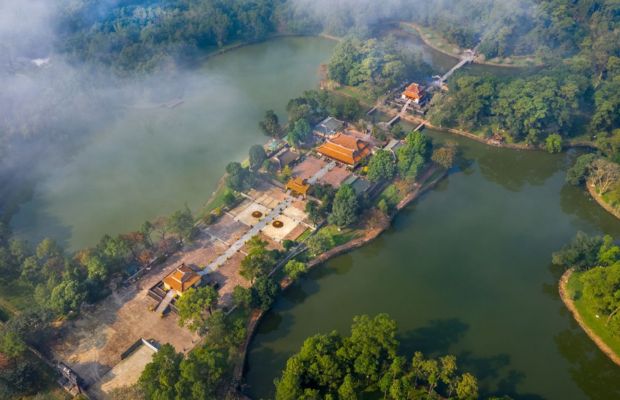
Minh Mang Tomb
Minh Mang Tomb is one of the royal tombs of the Nguyen Emperors you should visit. Visiting the tomb, you will be impressed with ancient traditional architecture, imbued with Confucian identity. The tomb is 12 kilometers from Hue City, surrounded by the Huong River, trees, and mountains. It took 14 years to find a suitable location and finally, Cam Khe Mountain was chosen as it converged all the elements of water, mountains, and green trees. After that, King Minh Mang changed the mountain's name to Hieu Son and named Hieu Lang the name of his tomb. The construction began in 1940 and was completed in 1943.
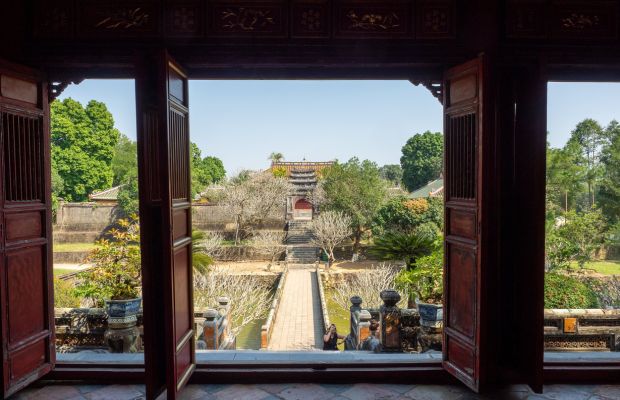
Minh Mang Tomb
The tomb has a total area of about 18 hectares, including 40 large and small constructions arranged symmetrically. The constructions are distributed on three large axes and parallel to each other, with Than Dao Road as the center. Coming to the Minh Mang Tomb, you should not miss Dai Hong Mon, the main gate of the tomb, Bai Dinh, the large yard paved with Bat Trang tiles, Lau Minh Lau, Tam Dien area, Tan Nguyet Lake, Thong Minh Chinh Truc Bridge, and Hien Duc Mon.
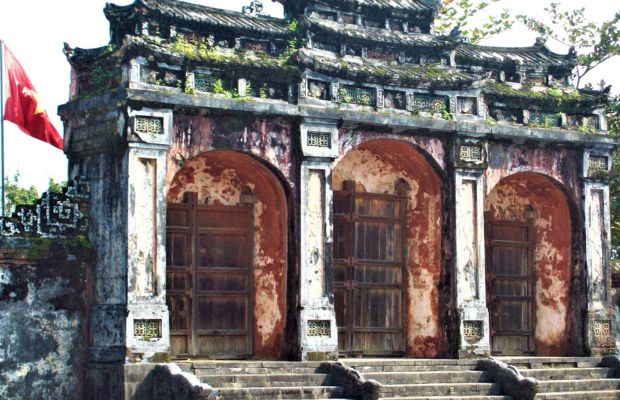
Dai Hong Mon inside Minh Mang Tomb
Tu Duc Tomb
- Address: Thuy Ba Village, Thuy Bieu Commune, Thuy Xuan Ward, Hue City, Thua Thien Hue Province
- Opening hours: 07.00 a.m. - 05.30 p.m.
- Entrance fee: VND 150,000/ turn/ adult
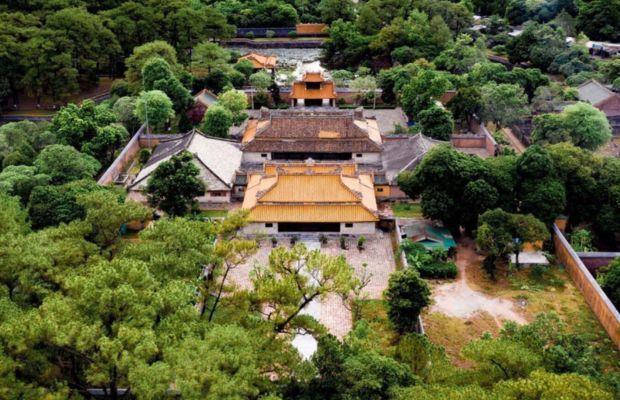
Tu Duc Tomb
Tu Duc Tomb is one of the most impressive royal tombs of the Nguyen Emperors. The tomb is just six kilometers from Hue City, so you can easily visit. Considered the most beautiful architectural construction of the Nguyen Dynasty, the tomb is the resting place of King Tu Duc, the reigning king among the 13 kings. The tomb was built in 1864 with the participation of 50,000 soldiers at that time. When it was first built, the tomb was called Van Nien Co, then was renamed Khiem Cung before being renamed Khiem Lang when the king died. Here are two amazing things to do in Tu Duc Tomb.
- Admiring the unique architecture of Tu Duc Tomb
There are nearly 50 constructions in the Tu Duc Tomb on both sides of the palace and the tomb. The tomb is outstanding in five areas: Khiem Cung Mon, Luong Khiem Palace, Minh Khiem Theatre, Tinh Khiem Island, and the tomb area.
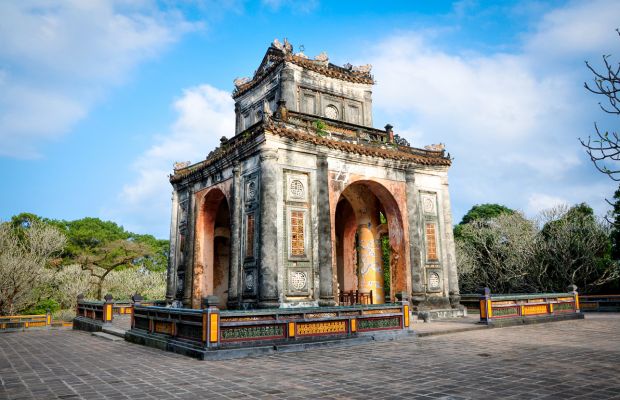
Tu Duc Tomb
- Enjoying the quiet atmosphere inside the tomb
The area of the Tu Duc Tomb is covered by an extremely cool green tree system. Visiting the tomb, you can enjoy fresh, clean air right in the middle of the charming landscape of Hue's mountains and forests.
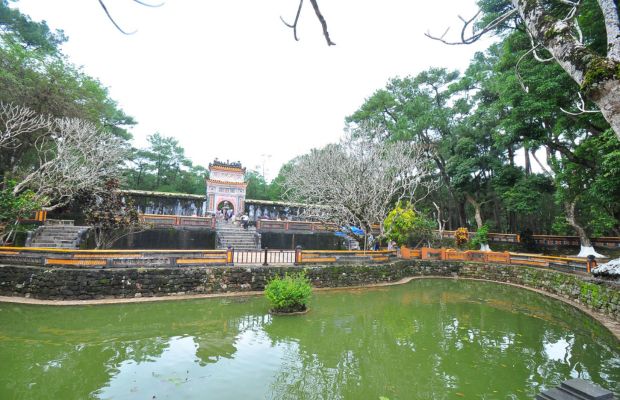
Enjoying the quiet atmosphere inside Tu Duc Tomb
Gia Long Tomb
- Address: Dinh Mon Village, Huong Tho Commune, Hue City, Thua Thien Hue Province
- Opening hours: 07.00 a.m. - 05.30 p.m.
- Entrance fee: VND 150,000/ turn/ adult
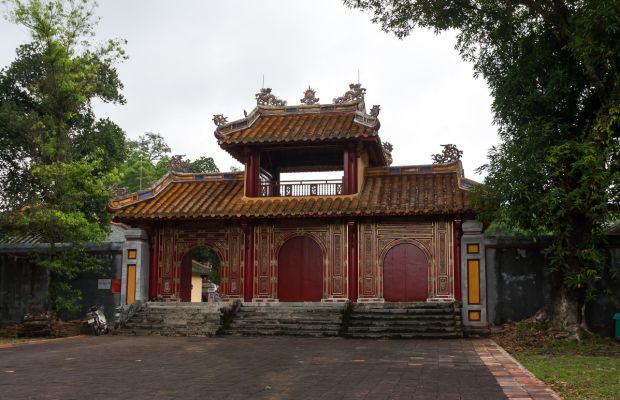
Gia Long Tomb
Gia Long Tomb, also known as the Thien Tho Tomb, was built in six years (1814 - 1820), including many tombs in the royal family of King Gia Long. The entire complex includes 42 large and small mountains and hills. Dai Thien Tho Mountain stands out in front of the tomb and 7 mountains behind it.
The tomb is divided into three areas: the tomb area, Bi Dinh, and Minh Thanh Palace. Let’s explore Gia Long Tomb’s architecture and these three areas.
- The tomb area - Buu Citadel
In the center of the complex are two double burial tombs of King Gia Long and Queen Thua Thien Cao, located on Chinh Trung Hill. Two stone tombs of the same size are placed just an inch apart. Although they are not carved with patterns and painted or gilded, they still stand the test of time and demonstrate the outstanding architectural talent of Vietnamese ancestors. Outside the two tombs is a solid wall system called the Buu Citadel. The bronze gate of Buu Citadel is the place leading to the resting place of the king and queen. Going through seven courtyard levels, two rows of stone statues of civil and military mandarins, and stone statues of war elephants and war horses, you can reach the tomb.
- Bi Dinh
Bi Dinh is located on the left of the tomb area, outstanding with two floors of roof covered with lapis lazuli tiles in the middle of the green space of the pine forest. It is a popular construction in most of the royal tombs of the Nguyen Emperors. Inside the Bi Dinh of the Gia Long Tomb, there is a stone stele called “Thanh Duc Than Cong” erected by King Minh Mang to praise the merit of King Gia Long. The stele is carved with delicate patterns and after nearly 200 years the letters are still clearly visible.
- Minh Thanh Palace
Minh Thanh Palace is located on the right of the tomb area, surrounded by walls. It is the place to worship the king and queen.
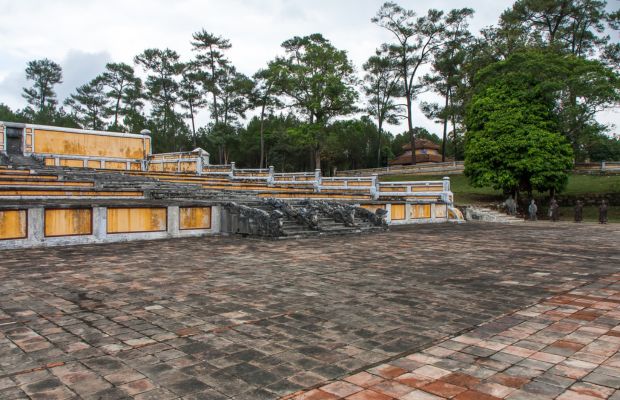
Gia Long Tomb
Besides the Thien Tho Tomb, the Gia Long Tomb complex also has other tombs of members of the Nguyen Thien Tho Huu Tomb, Quang Hung Tomb, Truong Phong Tomb, Vinh Mau Tomb, Thoai Thanh Tomb, Hoang Co Tomb, etc.
Khai Dinh Tomb
- Address: Thuy Bang Village, Huong Thuy Commune, Hue City, Thua Thien Hue Province
- Opening hours: 07.00 a.m. - 05.30 p.m.
- Entrance fee: VND 150,000/ turn/ adult
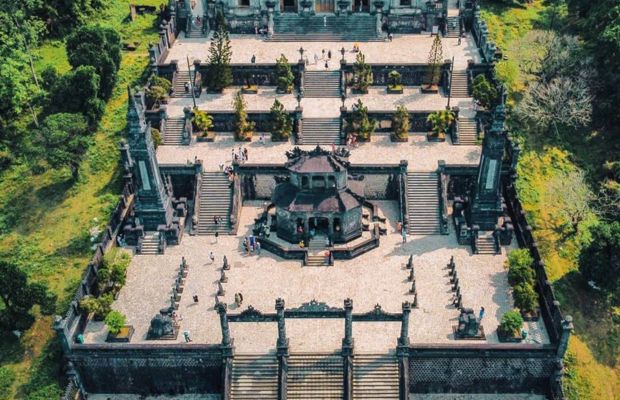
Khai Dinh Tomb
Khai Dinh Tomb, the last architectural construction in the Nguyen Dynasty of Vietnam, is one of the most unique and beautiful royal tombs of the Nguyen Emperors. It is located in the Chau Chu Mountain, about 10 kilometers from Hue City. The tomb’s construction started on September 4, 1920, and finished after 11 years. Although the total area of the tomb is not as large as other royal tombs of the Nguyen Emperors, it took a long time to complete and cost the most effort and money. Khai Dinh Tomb is a delicate combination of Eastern and Western architecture and culture, with elaborate, sophisticated, and splendid design.
The tomb is like a rectangular floating block, including 127 steps. Going through the first 37 steps, you will reach the Tam Quan Gate, followed by Nghi Mon and Bai Dinh Yard. Then there will be two floors of the yard, each floor is 13 steps apart. Thien Dinh Palace is at the highest position. Let’s explore outstanding sightseeing areas inside Khai Dinh Tomb with us!
- Tam Quan Gate
Tam Quan Gate, the entrance to Khai Dinh Tomb, stands out with its majestic architecture. You will need to step over 37 steps to get there. The pillars at the Tam Quan gate area were built in the Hindu style, showing the unique interference of Vietnamese and Indian culture and architecture.
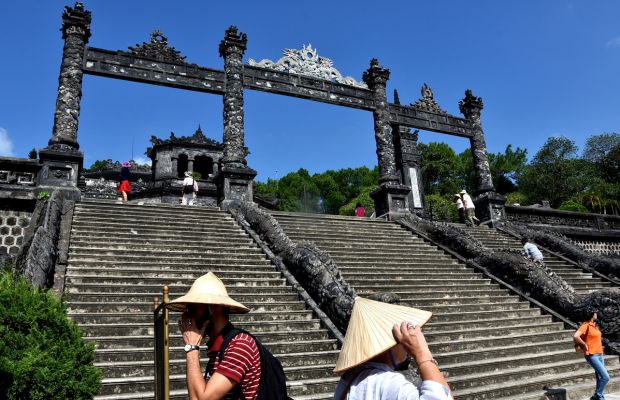
Tam Quan Gate
- Nghi Mon and Bai Dinh Yard
From Tam Quan Gate, you will continue stepping 29-step floors to Nghi Mon and Bai Dinh Yard area. Coming here, you will feel amazed by the statues of courtiers and soldiers arranged in four symmetrical rows. All statues are carved with extremely sophisticated patterns.
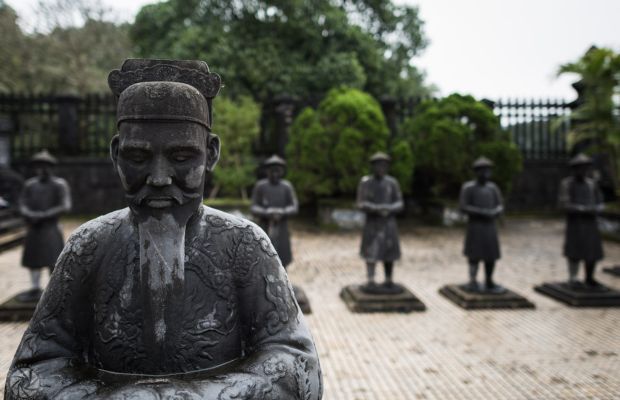
Bai Dinh Yard
- Thien Dinh Palace
Thien Dinh Palace is located on the highest floor of the Khai Dinh Tomb. This is the burial place of King Khai Dinh and is also the most unique sightseeing area that shows the creativity, innovation, and love of art of King Khai Dinh. Visiting this area, besides the outstanding architecture, you can also see a standing statue of the king with a ratio of 1-1.
- Khai Thanh Palace
Khai Thanh Palace is a part of Thien Dinh Palace, impressing tourists through its sophisticated architecture. In the middle of the palace, you can find Buu Tan, a precious parasol covering the king. It is made from reinforced concrete, weighing 1 ton. Besides, there is a statue of the king sitting on the throne here. This 1-1 scale statue was carved in 1920.
Thieu Tri Tomb
- Address: Thuy Bang Village, Huong Thuy Commune, Hue City, Thua Thien Hue Province
- Opening hours: 07.00 a.m. - 05.00 p.m.
- Entrance fee: VND 50,000/ turn/ adult
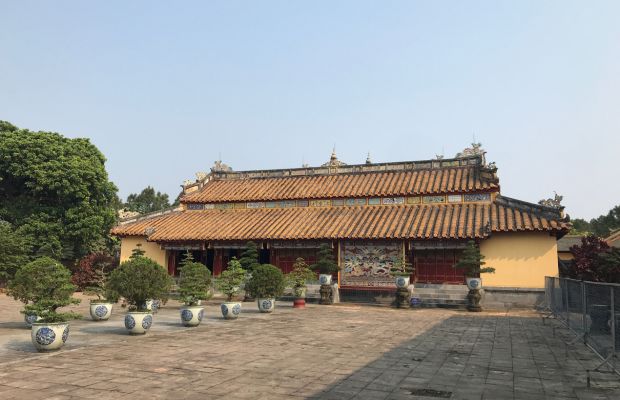
Thieu Tri Tomb
Thieu Tri Tomb, also known as Xuong Lang, is the resting place of King Thieu Tri - the third king of the Nguyen Dynasty. Compared to other royal tombs of the Nguyen Dynasty, this tomb has a different architectural style. The structure of the Thieu Tri Tomb includes two main areas: the tomb and the temple, and the communal house area. Let’s explore each of the areas with us!
- The tomb area in Thieu Tri Tomb
The tomb area is located on the right side of the Thieu Tri Tomb, on beautiful terrain. In front of the tomb area is the Nhuan Trach Lake connected to Dien Lake in the temple area through an underground sewer system. Behind the tomb area is a screen and Nghi Mon made of bronze carved in the shape of a dragon playing with clouds leading into Bai Dinh.
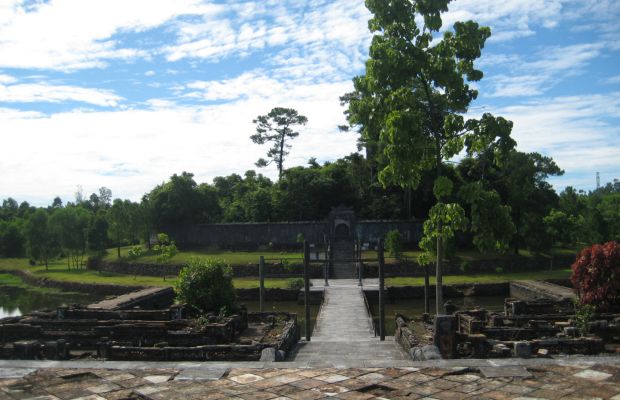
Thieu Tri Tomb
Like other royal tombs of the Nguyen Emperors, Thieu Tri Tomb’s Bai Dinh has two rows of solemn stone statues of mandarins, martial artists, horses, and elephants. Right behind Bai Dinh are Bi Dinh and Lau Duc Hinh located on a hill whose shape from afar looks like a turtle shell. The Bi Dinh area, also known as Phuong Dinh, is the place where you can find a statue of “Thanh Duc Tran Cong” with more than 2500 words written by King Tu Duc himself about the life and merits of his father.
- The temple and communal house area in Thieu Tri Tomb
The temple and communal house area were built in a unique style, about 100 meters from Duc Hinh Lau to the left. Behind Duc Hinh Pavilion is a flower garden built symmetrically on both sides. Next is Ngung Thuy Lake in front of Buu Thanh which has three bridges across it, including Chanh Trung Bridge in the middle, Dong Hoa Bridge on the right, and Tay Dinh Bridge on the left. All three bridges lead to Buu Thanh where King Thieu Tri’s body is buried. Besides, you can also find Nghi Mon and Hong Trach Mon inside this area.
Duc Duc Tomb
- Address: Phuoc Vinh Ward, Hue City, Thua Thien Hue Province
- Opening hours: 07.30 a.m. - 05.30 p.m.
- Entrance fee: free
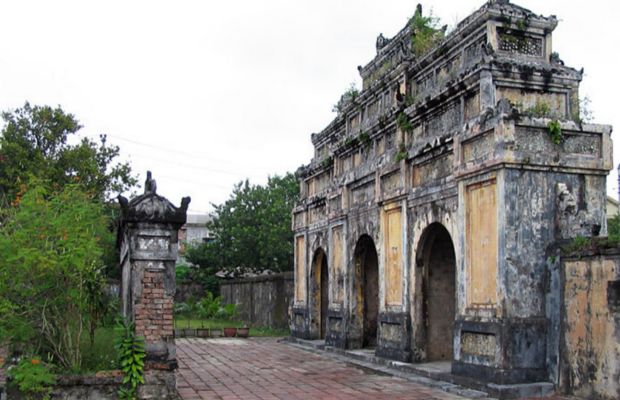
Duc Duc Tomb
Compared to other royal tombs of the Nguyen Emperors, Duc Duc Tomb has more modest and simple architecture. However, you will be amazed at the tomb’s ancient beauty when visiting the tomb. Duc Duc Tom, which is just about two kilometers from Hue’s city center, is also called An Lang. It is a common tomb of three king generations, which are King Duc Duc, King Thanh Thai, and King Duy Tan. There are two areas inside Duc Duc Tomb: Long An Palace and the Tombs of the King and Queen. Visiting this 56,144-square-meter tomb, you should not miss these ancient architectural constructions below.
- The tomb area with simple architecture
The tomb area has an acreage of 3,455 square meters. There are two floors with fake tile roofs above and a brick archway in front of the tomb. Unlike other royal tombs of the Nguyen Emperors with stone statues on two sides in the Bai Dinh area, Duc Duc Tomb’s Bai Dinh is only tiled on both sides.
After passing through Bai Dinh, you will come to the massive 3-storey Tam Quan Gate. The king and queen’s tombs are placed in the middle, surrounded by 3 layers of solid frames. The roof tiles are meticulously and carefully made of golden lapis lazuli.
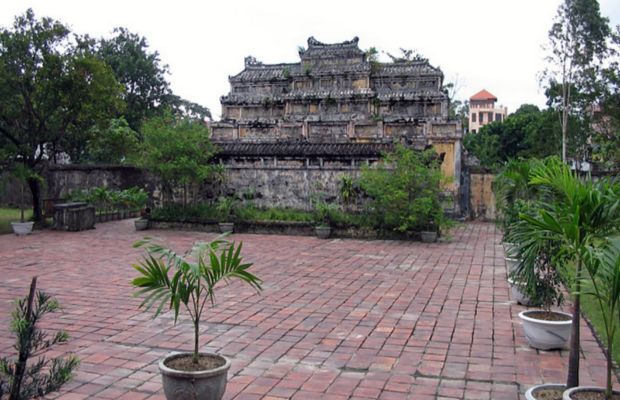
Duc Duc Tomb
- Tam Dien area
The tomb’s Tam Dien area has a total area of 6,245 square meters, located about 50 meters from the tomb area. The main gate is built in connection with the Tam Quan gate, with four floors of cement roof above.
- Long An Palace
Long An Palace has three compartments with three altars inside. They are the tablets of King Duc Duc and Queen Tu Minh Hue in the middle of the palace, the tablets of King Duy Tan on the right side, and King Thanh Thai on the left side.

Long An Palace
Dong Khanh Tomb
- Address: Thuong Hai Village, Thuy Xuan Commune, Hue City, Thua Thien Hue Province
- Opening hours: 07.30 a.m. - 05.30 p.m.
- Entrance fee: VND 100,000
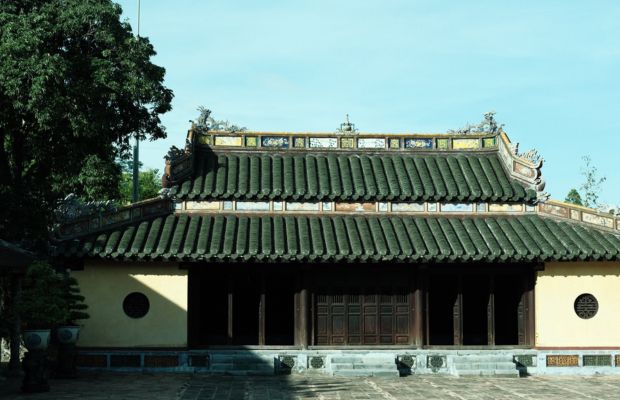
Dong Khanh Tomb
Dong Khanh Tomb is also known as Tu Lang, the tomb of the 9th king of the Nguyen Dynasty. It is also among the must-visit royal tombs of the Nguyen Emperors. Coming here, you will have a chance to learn about the long formation process of this tomb. It was built, repaired, and renewed within 35 years, experienced through 4 different kings from King Dong Khanh, King Thanh Thai, King Duy Tan to King Khai Dinh.
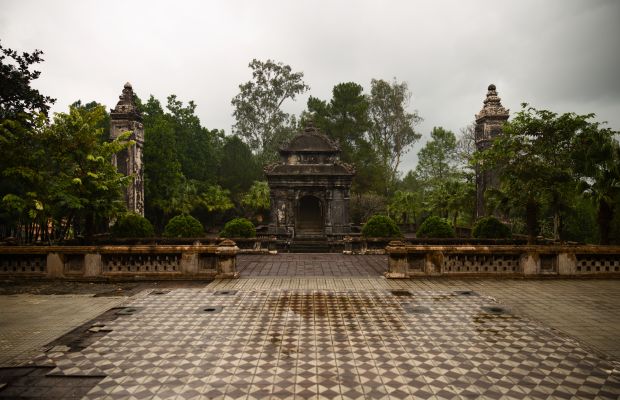
Dong Khanh Tomb
While Tu Duc Tomb has an ancient architectural style and Khai Dinh Tomb has a modern style, Dong Khanh Tomb has an interference of both architectures. The tomb bears the mark of two different historical times. The tomb’s palace area faces Southeast, impressed with traditional architectural style with a pair of vermillion lacquered and gilded wood panels. Whereas, the tomb area faces East - Southeast, taking Thien Thai mountain as a precedent. This area has a Western architectural style, from decorative motifs, and architectural lines to materials.
In conclusion, you have just known about the seven royal tombs of the Nguyen Emperors. Hope that these pieces of information can be helpful for your trip. For further information or to tailor your itinerary in Hue, please do not hesitate to contact us.
__logo.png)
__hanoi-water-puppets.jpg)
__angkor-wat-blue-reflections.jpg)
__vientiane-buddha-park-monks.jpg)
__bagan-dhammayazika-dusk.jpg)
